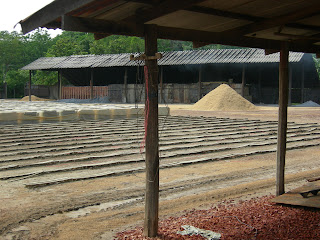That was what I knew of Ratchaburi until P'Jiap & P'Moo took me there to source for bricks & pre-fab slabs. Last weekend I visited Khao Bin cave and took opportunity to re-visit the brick & pre-fab yards which are close to each other.

What intrigue me is the contrast between the two. The pre-fab yard is a modern facility while the brick yard appears very much a cottage industry with business conducted as in old days.
The pre-fab process is straight forward and well mechanized. Large open yards where concrete poured over molds with steel wires in-laid.

Manufactured pre-fab slabs are neatly stack waiting for delivery.

Not far away is the granite quarry.

The brick yard is run by a matriarch from an open office. Seated on a spacious bench, she oversees & directs the entire operation. It is also where prices are negotiated & sales concluded. Notice the wall behind served as her memo pad.

And her potraits prominently displayed.

I am impressed by the simplicity of the brick making process.
Raw materials - clay

and ashes, residues from brick firing process.

Ashes are mixed with wet clay and manually fed into the mixer, which extrude into a long bar onto a roller bed. It is then wire cut to individual pieces and transfer to wooden trays to dry out in the sun.

It was not in operation on the day of visit, this young boy was keen to show where the "brick bar" is extruded.

Worker moving empty trays back into the brick extrusion shed.

It must be raining lately, wet bricks are laid out under a shed instead.

While those out in open yard are covered under plastic sheets.

I used to think bricks are normally fired in a furnace - well, this is how they do it here!
Dried bricks are loosely stack to 2m high and rice husks fill gaps in between. Zinc sheets are placed around the stacks boundary to contain the fire. It is a slow firing process that last about a week.

A closer view of the brick firing shed with smoldering smoke. Bricks are stack in a way allowing fresh air be drawn in to provide oxygen. On windy days they have to be vigilant as risk of fire spread increased.

Clever use of resources - rice husks as fuel sources, Thailand has plenty of it! Even its ashes are re-cycled as raw material in making of bricks.

Close up view of another mixer/extrusion machine with brick forming mold detached - the only part of process mechanized.

